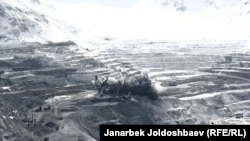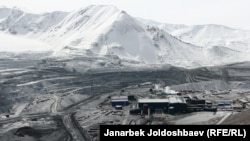Kyrgyzstan's Kumtor gold mine had only been in operation for months when one of its supply trucks crashed through a bridge, dumping more than a ton of toxic sodium cyanide into the Barskaun River. More than 2,500 people were poisoned.
The 1998 accident cost the mine $4.5 million in reparations and set the tone for years of discord between Kumtor's Canadian owners and local Kyrgyz who say the mine has not done enough to compensate for environmental damage.
In the latest standoff, thousands of protesters have blocked roads and disrupted power supplies to the massive open-pit mine, demanding better ecological standards and free medical facilities. Kyrgyz officials have declared a state of emergency in the district surrounding the mine.
The protests erupted just days before Kyrgyz officials had hoped to persuade Canada's Centerra Gold to sign a new contract raising its preferential 14 percent tax rate and demanding a $467 million payment for environmental damage. It now appears a deal may be postponed until the fall.
The delay is certain to frustrate many ordinary Kyrgyz who see the Kumtor mine, situated 4,000 meters above sea level in Kyrgyzstan's pristine Tien Shan mountains, as an ecological time bomb.
"Our women are giving birth prematurely. Our sheep and cows are suffering," said one protester. "Dear leaders, we're asking very kindly. We don't need gold. We don't need silver. We need clean water, healthy and good lives."
'Greater Challenge To Manage'
Kumtor has long raised concerns about the safety of downstream water supplies. The mine sits atop glaciers whose springtime meltwater feeds fresh water into the Naryn River, which flows toward Tajikistan, Kazakhstan, and Uzbekistan.
Gold mining, which typically relies on cyanide to extract gold from crushed rock, can create massive amounts of contaminated waste.
Although cyanide can naturally degrade within a matter of months if exposed to sunlight, the situation is complicated when glacial melt and groundwater come into contact with the contaminants.
Ramsey Hart, an environmental expert with the watchdog group MiningWatch Canada, says safety concerns become particular challenges in high-altitude mines like Kumtor.
"The cold temperatures can slow the degradation of cyanide down, so that will be one issue," Hart says. "And if you've got a lot of meltwater from the glaciers, that just complicates things. Any time you have a surplus of water at a mine site, it becomes a greater challenge to manage it, because if it comes in contact with the pit or the waste or the mine site's facilities, it's likely that it will become contaminated."
Environmentalists have also expressed alarm that glacial melt in the Tien Shan range has begun to accelerate, both as a result of climate change and the dark-gray mining residue that has settled over large swathes of Kumtor's glacial base, causing the range to absorb more heat.
Mining Past 2042?
Adding to worries is the fact that Kumtor's tailings -- or chemically polluted leftovers -- are located below a mountaintop body of water, Lake Petrov, which in recent years has swelled in size as a result of increased glacial melt.
Kyrgyz officials have expressed concern that the lake could eventually overflow, washing over the tailings deposit and sending the contaminants rushing downstream.
Kumtor, which is Central Asia's largest Western-owned mine, is also one of its most productive. The mine is projected to yield an average of 650,000 ounces of gold a year for the next 10 years, and Centerra says it has located additional deposits that may keep it at the site long past the expiration of its current contract in 2042.
PHOTO GALLERY: A Closer Look At The Kumtor Mine
Tenizbek Bolturukov, a mining expert who has advised the Kyrgyz government in its negotiations with Centerra, says the mine's healthy yields have only contributed to the environmental concerns.
"In the second half of 2012, the size of the waste deposits was 60 million cubic meters," he said. "According to construction guidelines, the waste can only grow to about 93 cubic meters before it begins to affect the stability of the dam holding it in."
Damning Evidence Of Threat
Centerra, which is Kyrgyzstan's largest taxpayer and accounts for some 12 percent of the country's total GDP, has steadily defended its environmental record in Kyrgyzstan.
As a Western company operating in a developing country, Centerra has generally avoided many of the restraints placed on mining companies operating in more developed countries -- including sizable "financial assurance" agreements that obligate a company to compensate for environmental damage even once a mine is closed.
Still, despite anecdotal accounts of premature births and dwindling fish stocks, official data has generally failed to provide damning evidence of the mine's threat to human health.
Health Ministry officials in the Jety-Oguz district surrounding the Kumtor mine say the number of birth defects reported in the region dropped by nearly 8 percent between 2011 and 2012.
And two foreign geological research institutes -- one German, one Slovenian -- hired by the Kyrgyz government to bolster its claim of Centerra's environmental recklessness have, in fact, given the mine a neutral assessment, saying downstream water samples did not reveal high levels of cyanide or other toxic elements.
The 1998 accident cost the mine $4.5 million in reparations and set the tone for years of discord between Kumtor's Canadian owners and local Kyrgyz who say the mine has not done enough to compensate for environmental damage.
In the latest standoff, thousands of protesters have blocked roads and disrupted power supplies to the massive open-pit mine, demanding better ecological standards and free medical facilities. Kyrgyz officials have declared a state of emergency in the district surrounding the mine.
The protests erupted just days before Kyrgyz officials had hoped to persuade Canada's Centerra Gold to sign a new contract raising its preferential 14 percent tax rate and demanding a $467 million payment for environmental damage. It now appears a deal may be postponed until the fall.
ALSO READ: Kyrgyz Prime Minister Meets With Kumtor Protesters
The delay is certain to frustrate many ordinary Kyrgyz who see the Kumtor mine, situated 4,000 meters above sea level in Kyrgyzstan's pristine Tien Shan mountains, as an ecological time bomb.
"Our women are giving birth prematurely. Our sheep and cows are suffering," said one protester. "Dear leaders, we're asking very kindly. We don't need gold. We don't need silver. We need clean water, healthy and good lives."
'Greater Challenge To Manage'
Kumtor has long raised concerns about the safety of downstream water supplies. The mine sits atop glaciers whose springtime meltwater feeds fresh water into the Naryn River, which flows toward Tajikistan, Kazakhstan, and Uzbekistan.
Gold mining, which typically relies on cyanide to extract gold from crushed rock, can create massive amounts of contaminated waste.
READ MORE: Kyrgyz Gold-Mine Protests Turn Violent
Although cyanide can naturally degrade within a matter of months if exposed to sunlight, the situation is complicated when glacial melt and groundwater come into contact with the contaminants.
Ramsey Hart, an environmental expert with the watchdog group MiningWatch Canada, says safety concerns become particular challenges in high-altitude mines like Kumtor.
"The cold temperatures can slow the degradation of cyanide down, so that will be one issue," Hart says. "And if you've got a lot of meltwater from the glaciers, that just complicates things. Any time you have a surplus of water at a mine site, it becomes a greater challenge to manage it, because if it comes in contact with the pit or the waste or the mine site's facilities, it's likely that it will become contaminated."
Environmentalists have also expressed alarm that glacial melt in the Tien Shan range has begun to accelerate, both as a result of climate change and the dark-gray mining residue that has settled over large swathes of Kumtor's glacial base, causing the range to absorb more heat.
Mining Past 2042?
Adding to worries is the fact that Kumtor's tailings -- or chemically polluted leftovers -- are located below a mountaintop body of water, Lake Petrov, which in recent years has swelled in size as a result of increased glacial melt.
Kyrgyz officials have expressed concern that the lake could eventually overflow, washing over the tailings deposit and sending the contaminants rushing downstream.
Kumtor, which is Central Asia's largest Western-owned mine, is also one of its most productive. The mine is projected to yield an average of 650,000 ounces of gold a year for the next 10 years, and Centerra says it has located additional deposits that may keep it at the site long past the expiration of its current contract in 2042.
PHOTO GALLERY: A Closer Look At The Kumtor Mine
Tenizbek Bolturukov, a mining expert who has advised the Kyrgyz government in its negotiations with Centerra, says the mine's healthy yields have only contributed to the environmental concerns.
"In the second half of 2012, the size of the waste deposits was 60 million cubic meters," he said. "According to construction guidelines, the waste can only grow to about 93 cubic meters before it begins to affect the stability of the dam holding it in."
Damning Evidence Of Threat
Centerra, which is Kyrgyzstan's largest taxpayer and accounts for some 12 percent of the country's total GDP, has steadily defended its environmental record in Kyrgyzstan.
As a Western company operating in a developing country, Centerra has generally avoided many of the restraints placed on mining companies operating in more developed countries -- including sizable "financial assurance" agreements that obligate a company to compensate for environmental damage even once a mine is closed.
Still, despite anecdotal accounts of premature births and dwindling fish stocks, official data has generally failed to provide damning evidence of the mine's threat to human health.
Health Ministry officials in the Jety-Oguz district surrounding the Kumtor mine say the number of birth defects reported in the region dropped by nearly 8 percent between 2011 and 2012.
And two foreign geological research institutes -- one German, one Slovenian -- hired by the Kyrgyz government to bolster its claim of Centerra's environmental recklessness have, in fact, given the mine a neutral assessment, saying downstream water samples did not reveal high levels of cyanide or other toxic elements.















